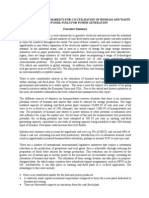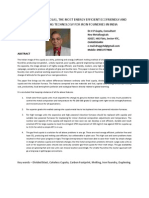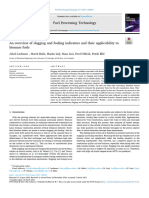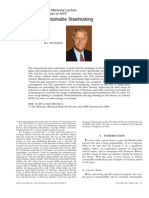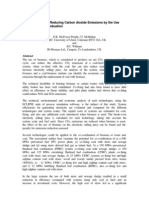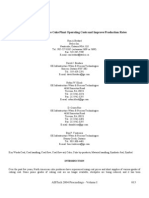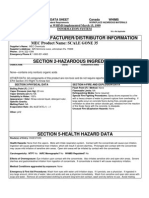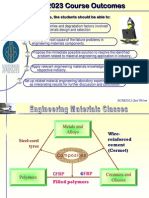PF 09 04 ccc147
PF 09 04 ccc147
Uploaded by
ukalCopyright:
Available Formats
PF 09 04 ccc147
PF 09 04 ccc147
Uploaded by
ukalOriginal Title
Copyright
Available Formats
Share this document
Did you find this document useful?
Is this content inappropriate?
Copyright:
Available Formats
PF 09 04 ccc147
PF 09 04 ccc147
Uploaded by
ukalCopyright:
Available Formats
June 2009 PF 09-04
Profiles
Slagging and fouling in coal-fired boilers
Predictive models are not capable of predicting ash impacts with sufficient reliability
that slagging incidents cost the global utility industry several billion dollars annually in reduced power generation and equipment maintenance. A previous IEA CCC report entitled Understanding slagging and fouling during pf combustion by Gordon Couch presented a comprehensive review of the topic at that time. The report summarised the state of knowledge in respect of boiler design and operation, ash formation and deposition, predictive techniques and remedial measures. A later IEA CCC report, also by Gordon Couch entitled Ash management in coal-fired power plants, covering a number of ash-related issues, addressed some of the more recent developments in the field of slagging and fouling but a number of significant changes have continued to reshape the power generation sector which warrant this updated study of the topic. This report sets out to consider how the
. . . and in extreme cases a boiler can be shut down by ash-related problems
Slagging occurs in boiler furnaces where ash deposits are exposed to the radiant heat of the coal flames, while fouling occurs in the boilers convective passes. The propensity of a coal or a blend of coal with other fuels for producing slagging and fouling deposits depends on its ash content and, more importantly, the composition of that ash, and how the ash behaves under the conditions within the boiler during and after the combustion of the accompanying carbonaceous matter. The fact that the propensity for slagging and fouling problems is governed by the complex interaction between a boilers operating conditions and the coal ash chemistry makes the prediction of slagging and fouling very difficult. Excessive ash deposits on a coalfired boilers heat transfer surfaces will reduce its efficiency, and in extreme cases a boiler can be shut down by ashrelated problems. It has been estimated
Cofiring of other fuels with coal represents one of the biggest challenges to power plant operation
understanding of the slagging and fouling process has developed, how changes in the utility sector have impacted on the importance and likelihood of ash deposition incidents, and how problems may be predicted and tackled on a practical level. Some important factors which impact on the topic are considered in this review including: G power generation sector deregulation; G technological developments; G environmental protection technologies; G new technologies; G cofiring with biomass and other alternative fuels; G increased international coal trading. Developments in the global coalfired power generation sector continue to influence the subject in a number of ways. Increased competition between utility companies has led to the use of
Slag on platen superheater tubes
Superheater platens at Matia power station, South Africa
coals whose properties are often far removed from the coals specified for the original boiler design. The changing electricity market in many areas where the use of fuels other than coal (for example gas) has become widespread, has led to coal-fired plant being operated in some regions (for example OECD countries) under regimes other than base load. This change in operation has helped to reduce boiler slagging to some degree through the regular shedding of deposits as the boiler is thermally cycled. The increasing pressure on coal-fired power stations to reduce emissions has led to the development of technologies for the abatement of specific pollutants that impact on ash slagging. Combustion modifications for NOx reduction are considered the most significant and have, through a trend towards larger furnaces and cooler flames, generally reduced slagging propensity. Where coal switching has taken place for sulphur control, lowsulphur coals have been used in boilers not designed for them, with consequent problems. The best example of this is the increased use of Powder River Basin coal in US plant, where the low cost, low sulphur characteristics provide a powerful imperative for solutions to any problems arising from their use. CFBC plants in the power generation market are particularly effective with very low grade coals. The different combustion environment, compared to pulverised coal fired plant, gives rise to unique ash-related problems such as bed agglomeration. The new generation of pulverised coal fired plant, designed for high efficiency through the use of high steam temperatures and pressures, present the greatest challenge with respect to ash slagging and fouling. These new plant are almost certain to be required to operate under conditions that allow carbon capture and storage, for compliance with climate change driven requirements. The leading technology for this is oxy-firing and represents a very substantial change to combustion conditions within the boiler. It is regarded by boiler manufacturers, users and academic researchers as warranting significant study to identify and ameliorate any issues arising from the new combustion environment. The cofiring of other fuels with coal, especially biomass represents the one of the biggest challenges to power plant
operation in the last fifteen years. A large number of fuels have been studied at laboratory, pilot and full scale and many are now in regular use in operating plants. The ash chemistry of these alternative fuels is often very different to that of the coals and has given rise to serious problems, particularly in the early days of cocombustion. The alkali metals are particularly important in deposit initiation and growth and care has to be taken when selecting biofuels and establishing the appropriate coal replacement levels for cocombustion. However, the widespread practice of cofiring has demonstrated that these problems can be overcome, with minimum ash-related impact on plant operation. Although predictive models for slagging and fouling are now in widespread use, they are not thought to be capable of predicting ash impacts with sufficient reliability in all cases. The sub-models are thought to be at an advanced stage of development, but overall, model integration is still thought to require development. The prediction of ash impacts is generally thought to be more reliably achieved through a combination of predictive indices, models, historical information on coal and boiler performance and experience.
IEA Clean Coal Centre is a collaborative project of member countries of the International Energy Agency (IEA) to provide information about and analysis of coal technology, supply and use. IEA Clean Coal Centre has contracting parties and sponsors from: Australia, Austria, Brazil, Canada, China, Denmark, the European Commission, Germany India, Italy, Japan, Republic of South Korea, the Netherlands, New Zealand, Poland, Russia, South Africa, Sweden, Spain, Thailand, the UK and the USA.
Each issue of Profiles is based on a detailed study undertaken by IEA Clean Coal Centre, the full report of which is available separately. This particular issue of Profiles is based on the report: Slagging and fouling in coal-fired boilers Ian Barnes CCC/147, ISBN 978-92-9029-466-5, 43 pp, April 2009, 255*/85/42.50
* non-member countries member countries educational establishments within member countries
Gemini House 10-18 Putney Hill London SW15 6AA United Kingdom Tel: +44 (0)20 8780 2111 Fax: +44 (0)20 8780 1746 e-mail: mail@iea-coal.org > Internet: www.iea-coal.org
You might also like
- Astm F723Document17 pagesAstm F723Sunantha KaenthongNo ratings yet
- Cleaning Plate Heat Exchangers PDFDocument2 pagesCleaning Plate Heat Exchangers PDFukalNo ratings yet
- ASSIST - Bromine Water - 2019-02-22Document5 pagesASSIST - Bromine Water - 2019-02-22JMNo ratings yet
- Refractory MaterialsDocument16 pagesRefractory MaterialsPradeep Gade50% (2)
- Coal-Fired Power Plant Planning AssumptionsDocument17 pagesCoal-Fired Power Plant Planning AssumptionsSandipan BhowmickNo ratings yet
- Alstom - Integrated Solutions For Coal-Fired Power PlantsDocument3 pagesAlstom - Integrated Solutions For Coal-Fired Power PlantsAlmario SagunNo ratings yet
- Coping With Coal Quality Impacts On Power Plant Operation and MaintenanceDocument3 pagesCoping With Coal Quality Impacts On Power Plant Operation and MaintenancemkgchemNo ratings yet
- Biomass-Coal Co-CombustionDocument12 pagesBiomass-Coal Co-CombustionsebascianNo ratings yet
- Biomass Power GenerationDocument90 pagesBiomass Power GenerationPrapan KuchontharaNo ratings yet
- Biomass MITDocument9 pagesBiomass MITJimmy Nuñez VarasNo ratings yet
- A Review On Boiler Deposition-Foulage Prevention and Removal Techniques For Power PlantDocument6 pagesA Review On Boiler Deposition-Foulage Prevention and Removal Techniques For Power PlanthozipekNo ratings yet
- 1 s2.0 S095965261930647X AmDocument37 pages1 s2.0 S095965261930647X AmPriyatam KumarNo ratings yet
- Clean Ironmaking and Steelmaking Processes: Efficient Technologies for Greenhouse Emissions AbatementFrom EverandClean Ironmaking and Steelmaking Processes: Efficient Technologies for Greenhouse Emissions AbatementNo ratings yet
- Buy Ebook Clean Ironmaking and Steelmaking Processes Efficient Technologies For Greenhouse Emissions Abatement Pasquale Cavaliere Cheap PriceDocument62 pagesBuy Ebook Clean Ironmaking and Steelmaking Processes Efficient Technologies For Greenhouse Emissions Abatement Pasquale Cavaliere Cheap Pricepyrzforche100% (2)
- Calin-Cristian Cormos: SciencedirectDocument8 pagesCalin-Cristian Cormos: SciencedirectBidesh M KirtaniaNo ratings yet
- Final Report Reduction of GHG Emissions in Steel IndustriesDocument110 pagesFinal Report Reduction of GHG Emissions in Steel Industriesmohit madaviNo ratings yet
- MTH2 Steel 2023 JV SDocument10 pagesMTH2 Steel 2023 JV SOctavio CarvajalNo ratings yet
- v112n04p301 Economic Modelinf FeCr FurnaceDocument8 pagesv112n04p301 Economic Modelinf FeCr FurnaceergfaradNo ratings yet
- Power Plant Optimization Demonstration Projects: Topical Report Number 25 September 2007Document28 pagesPower Plant Optimization Demonstration Projects: Topical Report Number 25 September 2007Nayan MannaNo ratings yet
- Ambre Submission To CPRSDocument2 pagesAmbre Submission To CPRSfreddy feltonNo ratings yet
- Role of Various Factors On Coal CombustionDocument51 pagesRole of Various Factors On Coal CombustionAbhijeet DuttaNo ratings yet
- Carbon CaptureDocument8 pagesCarbon CapturePRATYUSH PRAKASHNo ratings yet
- Coal Selection CriteriaDocument31 pagesCoal Selection CriteriaHardik Kumar MendparaNo ratings yet
- Duplexing From Cupolas - DrV.P.guptaDocument16 pagesDuplexing From Cupolas - DrV.P.guptaVirendra GuptaNo ratings yet
- Coal To Methanol p2Document8 pagesCoal To Methanol p2moeeezNo ratings yet
- Coal PreparationDocument38 pagesCoal PreparationJerry MateoNo ratings yet
- Blends CoalDocument3 pagesBlends CoalJesús CortésNo ratings yet
- Deployment of CCS in The Cement IndustryDocument139 pagesDeployment of CCS in The Cement IndustryJonson CaoNo ratings yet
- Project StatementDocument2 pagesProject StatementashrafNo ratings yet
- ART - F5 - PWR - PRB Coal Users Group Industry KnowledgeDocument4 pagesART - F5 - PWR - PRB Coal Users Group Industry KnowledgeGothandaraman Muthu ManickamNo ratings yet
- Coal Combustion TechnologiesDocument31 pagesCoal Combustion TechnologiesFawad MushtaqNo ratings yet
- A Techno-Economic Assessment of The Reduction of Carbon Dioxide Emissions Through The Use of Biomass Co-CombustionDocument8 pagesA Techno-Economic Assessment of The Reduction of Carbon Dioxide Emissions Through The Use of Biomass Co-CombustionAnonymous XBq5J84No ratings yet
- Blending of Coals in Power StationsDocument20 pagesBlending of Coals in Power StationsPankaj GuptaNo ratings yet
- Chem EngineeringDocument61 pagesChem EngineeringVIMALNo ratings yet
- Energies 16 02140 v2Document25 pagesEnergies 16 02140 v2محمود المغيري محمود المغيريNo ratings yet
- Clean Coal ThesisDocument7 pagesClean Coal Thesisdwnt5e3k100% (2)
- The Future For Biomass Pyrolysis and Gasification: Status, Opportunities and Policies For EuropeDocument30 pagesThe Future For Biomass Pyrolysis and Gasification: Status, Opportunities and Policies For EuropeHartono PrayitnoNo ratings yet
- Metals 10 01535Document26 pagesMetals 10 01535Musa KaleemNo ratings yet
- Claudia Bassano, Paolo Deiana, Giuseppe Girardi: HighlightsDocument11 pagesClaudia Bassano, Paolo Deiana, Giuseppe Girardi: HighlightsSorrawit TantipalakulNo ratings yet
- Industrial Waste As Alternative Fuel in Cement Industry Its Impact On Environment PDFDocument7 pagesIndustrial Waste As Alternative Fuel in Cement Industry Its Impact On Environment PDFAnonymous NxpnI6jCNo ratings yet
- Es327 PFSDocument10 pagesEs327 PFShmzaheer2002No ratings yet
- Future of The Gas Networks: Policy Issues: A Diminishing Role For Gas in The UK Energy System?Document2 pagesFuture of The Gas Networks: Policy Issues: A Diminishing Role For Gas in The UK Energy System?oleolo ibrahimNo ratings yet
- Coal-Fired Power Plant Heat Rate Improvement Options, Part 1 - PowermagDocument12 pagesCoal-Fired Power Plant Heat Rate Improvement Options, Part 1 - PowermagRavi Satyapal100% (1)
- Preprints202310 0856 v1Document9 pagesPreprints202310 0856 v1tomas.aristaNo ratings yet
- Survival Fuels: Technical ForumDocument2 pagesSurvival Fuels: Technical ForumElwathig Bakhiet100% (1)
- Assessment of CO2 Capture Technologies in Cement Manufacturing ProcessDocument11 pagesAssessment of CO2 Capture Technologies in Cement Manufacturing ProcessSalah SalmanNo ratings yet
- An Overview of Slagging and Fouling Indicators and Their Applicability To Biomass FuelsDocument10 pagesAn Overview of Slagging and Fouling Indicators and Their Applicability To Biomass FuelsDheeraj NigotiyaNo ratings yet
- Bhel JournalDocument68 pagesBhel JournalChaitanya Raghav SharmaNo ratings yet
- Research On Sustainable Steel Making (Fruehan)Document11 pagesResearch On Sustainable Steel Making (Fruehan)vikassolanki2010No ratings yet
- Biomass CocombustionDocument10 pagesBiomass Cocombustionbdave29No ratings yet
- Coal Flow Improves Coke Process-IMPDocument11 pagesCoal Flow Improves Coke Process-IMPsamdanismsNo ratings yet
- Coal-Fired Power Plant Heat Rate Improvement Options, Part 1Document13 pagesCoal-Fired Power Plant Heat Rate Improvement Options, Part 1Ravi Satyapal100% (1)
- Coal To Coke PDFDocument9 pagesCoal To Coke PDFVenkata Krishnan RamanujamNo ratings yet
- Slagging Fouling in CofiringDocument18 pagesSlagging Fouling in CofiringAlzaem NasserNo ratings yet
- The Usability and Limits of The Steady Flamelet Approach in Oxy-Fuel CombustionsDocument13 pagesThe Usability and Limits of The Steady Flamelet Approach in Oxy-Fuel CombustionsCehanNo ratings yet
- Carbon Foot Print Reduction SteelDocument17 pagesCarbon Foot Print Reduction Steelyuri67No ratings yet
- LO - A Review of Decarbonization Options For The Glass IndustryDocument31 pagesLO - A Review of Decarbonization Options For The Glass IndustryRaulNo ratings yet
- Petcoke For Lime KilnDocument44 pagesPetcoke For Lime KilnHuyentrang Nguyen75% (4)
- 1 s2.0 S0016236123000145 MainDocument7 pages1 s2.0 S0016236123000145 MainSrikanth SrikantiNo ratings yet
- International Journal of Greenhouse Gas Control: SciencedirectDocument15 pagesInternational Journal of Greenhouse Gas Control: SciencedirectdanielsmattosNo ratings yet
- Beating US$10 Per Pound of Installed Capacity For A Laterite Nickel Plant 01 - 05Document8 pagesBeating US$10 Per Pound of Installed Capacity For A Laterite Nickel Plant 01 - 05SyafrullahNo ratings yet
- Innovation in Electric Arc Furnaces: Scientific Basis for SelectionFrom EverandInnovation in Electric Arc Furnaces: Scientific Basis for SelectionNo ratings yet
- Fossil Fuel Hydrogen: Technical, Economic and Environmental PotentialFrom EverandFossil Fuel Hydrogen: Technical, Economic and Environmental PotentialNo ratings yet
- Plate Heat ExchangerDocument28 pagesPlate Heat ExchangerFRANCISCO JOSE GARCIA IBAÑEZ100% (1)
- Plate Heat Exchanger ManualDocument20 pagesPlate Heat Exchanger ManualRosa Jasmene100% (1)
- GPHE MANUAL EN - tcm11 7537 PDFDocument36 pagesGPHE MANUAL EN - tcm11 7537 PDFukalNo ratings yet
- ViFlow Funke GB PDFDocument8 pagesViFlow Funke GB PDFukalNo ratings yet
- Modeling and Design of Plate Heat ExDocument36 pagesModeling and Design of Plate Heat ExSutaTarNo ratings yet
- Lic Fredrik Olsson Friblick PDFDocument170 pagesLic Fredrik Olsson Friblick PDFukalNo ratings yet
- Construction Purchasing/Procurement Manager: West Coast OpportunityDocument2 pagesConstruction Purchasing/Procurement Manager: West Coast OpportunityukalNo ratings yet
- Manual "Procurement Strategy in Construction": Leonardo Da Vinci Toi Project Train-To-CapDocument111 pagesManual "Procurement Strategy in Construction": Leonardo Da Vinci Toi Project Train-To-CapukalNo ratings yet
- Robert Fox PresentationDocument27 pagesRobert Fox PresentationKapil SharmaNo ratings yet
- Palm-Based General Cleaning Agent: DegreaserDocument2 pagesPalm-Based General Cleaning Agent: DegreaserukalNo ratings yet
- Material Safety Data Sheet: Product Information On IngredientsDocument6 pagesMaterial Safety Data Sheet: Product Information On IngredientsukalNo ratings yet
- Purchasing Fundamentals PDFDocument17 pagesPurchasing Fundamentals PDFukalNo ratings yet
- Ferrolex D - 15: Technical DataDocument1 pageFerrolex D - 15: Technical DataukalNo ratings yet
- Material Safety Data Sheet: 1. Information On IngredientsDocument3 pagesMaterial Safety Data Sheet: 1. Information On IngredientsukalNo ratings yet
- Material Safety Data Sheet: Information On IngredientsDocument3 pagesMaterial Safety Data Sheet: Information On IngredientsukalNo ratings yet
- 03 - 3 - Atlantic City - 09-59 - 0116Document8 pages03 - 3 - Atlantic City - 09-59 - 0116ukalNo ratings yet
- Information On IngredientsDocument3 pagesInformation On IngredientsukalNo ratings yet
- Material Safety Data Sheet: Information On IngredientsDocument6 pagesMaterial Safety Data Sheet: Information On IngredientsukalNo ratings yet
- Scale Gone MSDSDocument2 pagesScale Gone MSDSukalNo ratings yet
- Isomerism: TypesDocument9 pagesIsomerism: TypesKabali KumarNo ratings yet
- APNDocument27 pagesAPNAngelina LampaNo ratings yet
- Sa 213Document11 pagesSa 213gst ajahNo ratings yet
- An Experimental Verification of Saturated Salt Solution-Based Humidity Fixed PointsDocument17 pagesAn Experimental Verification of Saturated Salt Solution-Based Humidity Fixed PointsRODRIGONo ratings yet
- Urinalisis: Dr. Cici Julia Sri Dewi, SP - PKDocument37 pagesUrinalisis: Dr. Cici Julia Sri Dewi, SP - PKOktavia ManullangNo ratings yet
- Ordinary Pressure Gauges: (Silver M)Document6 pagesOrdinary Pressure Gauges: (Silver M)RofiNo ratings yet
- Review Summary NFS - ESW-AJB-SH-PRC-00064-00Document16 pagesReview Summary NFS - ESW-AJB-SH-PRC-00064-00Fahad Abdul HaqNo ratings yet
- UNIT 2 Crystallography and Xray DiffDocument22 pagesUNIT 2 Crystallography and Xray Diffshaikshafina7107No ratings yet
- Chem Kinet Meeting 2Document27 pagesChem Kinet Meeting 2Nuril AzmiNo ratings yet
- 01 Mechanical Properties of Materials Jan09 StdNotesDocument34 pages01 Mechanical Properties of Materials Jan09 StdNotesRusYz AvVeroezNo ratings yet
- Research Lesson Plan - Gas Laws JudeDocument16 pagesResearch Lesson Plan - Gas Laws JudeChristian PrudencianoNo ratings yet
- MicrofabricationDocument6 pagesMicrofabricationNeethu Krishna KNo ratings yet
- Metode Flying Start and FinsihDocument2 pagesMetode Flying Start and FinsihSeptian MambrasarNo ratings yet
- BaBiO3 VIDocument50 pagesBaBiO3 VIYhomn AcerNo ratings yet
- Week 15 Environmental Science Pollution and Its FactorsDocument22 pagesWeek 15 Environmental Science Pollution and Its FactorsReine Jholo BagaipoNo ratings yet
- REACH Annex XVII Status 1904Document21 pagesREACH Annex XVII Status 1904MarkChenNo ratings yet
- Experiment That Shows Selective Permeability of PotatoesDocument5 pagesExperiment That Shows Selective Permeability of Potatoesapi-327023114No ratings yet
- Msds Crude Glycerin PDFDocument7 pagesMsds Crude Glycerin PDFpequenita34No ratings yet
- Jitps 09Document11 pagesJitps 09vetpradeepNo ratings yet
- Quantum Dot-Aluminum Phthalocyanine Conjugates Perform Photodynamic Reactions To Kill Cancer Cells Via Fluorescence Resonance Energy TransferDocument8 pagesQuantum Dot-Aluminum Phthalocyanine Conjugates Perform Photodynamic Reactions To Kill Cancer Cells Via Fluorescence Resonance Energy TransferAnneNo ratings yet
- MSDS 1044 EngDocument9 pagesMSDS 1044 EngchimexportNo ratings yet
- Laboratory Report 4 Group 6Document5 pagesLaboratory Report 4 Group 6Lyka Jane BucoNo ratings yet
- CHEMISTRYDocument28 pagesCHEMISTRYdarshnaNo ratings yet
- D3997-Standard Practice For Preparing Coke Samples For Microscopical Analysis by Reflected LightDocument3 pagesD3997-Standard Practice For Preparing Coke Samples For Microscopical Analysis by Reflected LightAyaNo ratings yet
- Racementhol - British Pharmacopoeia PDFDocument3 pagesRacementhol - British Pharmacopoeia PDFwilNo ratings yet
- Bio f4 Chapter 3 NotesDocument20 pagesBio f4 Chapter 3 NotesSaidatul Atyah Mohd ApendaiNo ratings yet
- Bep Rev.c-New 20 MLD WTP, NathavaliDocument380 pagesBep Rev.c-New 20 MLD WTP, NathavaliAnonymous 7l8AIyq2100% (1)








